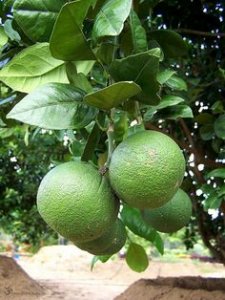Description
The deciduous tree with trifoliate leaves is traditionally used as a sacred, offering by Hindus in India to Lord Shiva.
What makes it special:
- Thehard shelled fruits are exquisitely aromatic.
- Refreshing juice and preserves.
Bael is botanically known as Aegle marmelos ant it is deciduous tree with trifoliate leaves. The branches sometimes bear long straight spines. The bark is shallowly furrowed and corky. Bael is an indigenous fruit tree of India.
Bael grows in wild and semi-wild in the North India states of Uttar Pradesh, Orissa, Bihar, West Bengal, and Madhya Pradesh. It is considered holy in Hindu religion and the leaves are used as offerings for Lord Shiva.The flowering season starts in late May. It has pale yellowish green sweetly scented flowe The slightly pear-shaped fruits are green in color and turn yellowish on ripening.
Plant Specifications
|
Plant Height |
24 inch (61 cm) |
|
Plant Spread |
5 inch (13 cm) |
*above specification are indicative only. actual dimensions may vary by +-10%
|
Common Name |
Bel patra |
|
Maximum Reachable Height |
Up to 10 meter |
|
Flower Colour |
Yellowish green |
|
Bloom Time |
April-May |
|
Difficulty Level |
Easy |
Planting And Care
Refer our Garden Guide for detailed procedures and meanings of words related to gardening.
Light Requirement
- More than 6 hours of sunlight a day is ideal for plant to grow well and natural direct bright light for the rest of the day.Soil
- The soil should be well drained and fertile, rich in organic content for growing plant.Watering
- Poke your finger/plain small stick into the soil to check the moisture.
- Apply 4 cup (Approx. 200 ml) water when top soil (1-2 inches) in pot feels dry to touch.
- As rule of thumb, Water the plant thoroughly in the summer and reduce watering in winter and rainy season.
- Do not over-water the plant.
- Apply water preferably in morning or evening.Application of Fertilizer
- Loosen the topsoil without disturbing the roots of the plant so it can uptake the nutrients and moisture easily.
- During the main growing season feed the plant with organic fertilizer once a month (Oct-Jan).
- Apply water immediately after application of fertilizer.
Re-potting - When a plant outgrows in current pot, re-pot with fresh potting soil and some fertilizer.
- Do the re-potting late evening and keep the plant in shady area for 2 to 3 days and then move the plant in its suitable growing condition.For re-potting procedure click here
Plant Protection - Remove dead, infected or damaged plant parts and dispose them away from the planting area.
- Spray Neem, Eucalyptus or Citrus oil for any insect/pest attack, as a primary treatment.
Donts - Do not over water the plant especially when pot does not have drainage holes.
- Avoid applying water on flowers and leaves it may cause fungus infection.
Bel Tree Care
Initial care for 1-2 weeks after receiving plant at your location:
- Keep the plant in Natural indirect bright Light.
- Poke your finger/plain small stick into the soil to check the moisture.
- Apply 4 cup (Approx. 200 ml) water when top soil (1-2 inches) in pot feels dry to touch.
- Do not re-pot for min. 2 weeks after receiving it.
Key requirements to keep plant healthy:
|
Sunlight |
More than 6 hours of sunlight a day is ideal for plant and natural direct bright light for the rest of the day. |
|
Watering |
Apply 4 cup (Approx. 200 ml) water when top soil (1-2 inches) in pot feels dry to touch. |
|
Soil |
Soil should be well drain and fertile, rich in organic content. |
|
Temperature |
20 to 35 degree Celsius |
|
Fertilizer |
Apply any organic fertilizer once a month (Oct-Jan). |
Bel Tree Special Feature
Sacred plant
Bel Tree Uses
Medicinal Use:
- Bel benefits in healing digestive disorders, ulcers, headache, hypertension, diabetes, and numerous other ailmentsThe ripe fruit works as a laxative but is not digested easilyUnripe bel fruit, on the other hand, promotes digestion and cures diarrhea
- Note: Use only after consulting the Health specialist
Culinary Use:
- The pulp is often processed as nectar or squash (diluted nectar)
| Shipping Cost |
|
| Shop Location |
No reviews found!














No comments found for this product. Be the first to comment!